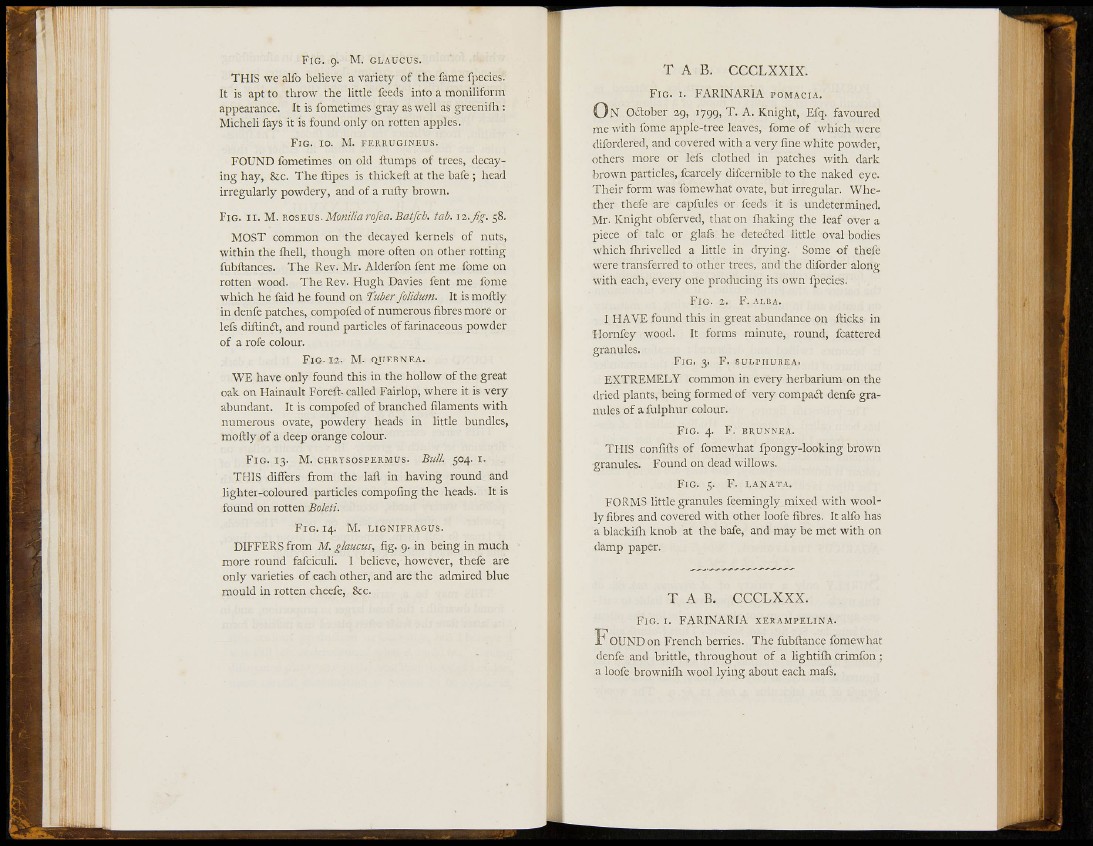
F I G . 9. M. GLAUCUS.
THIS we alfo believe a variety of the fame fpecies.
It is apt to throw the little feeds into a moniliform
appearance. It is fometimes gray as well as grcenilh :
Micheli fays it is found only on rotten apples.
FIG. 10. M. FERRUGINEUS.
FOUND fometimes on old flumps of trees, decaying
hay, &c. The flipes is thickeft at the bafe ; head
irregularly powdery, and of a rufty brown.
FIG. II. M. -Ko^ivs. Monilia rofea. Batfch. tab. ii-fig. 58.
MOST common on the decayed kernels of nuts,
within the flrell, though more often on other rotting
fubftances. The Rev. Mr. Alderfon fent me fome on
rotten wood. The Rev. Hugh Davies fent me fome
which he faid he found on Tuber Jolidum. It is moftly
in denfe patches, compofed of numerous fibres more or
lefs diftindl, and round particles of farinaceous powder
of a rofe colour.
F I G . 12. M. QJJERNEA.
WE have only found this in the hollow of the great
oak on Hainault Foreft- called Fairlop, where it is very
abundant. It is compofed of branched filaments with
numerous ovate, powdery heads in little bundles,
moftly of a deep orange colour.
FIG. 13. M. CHRYSOSPERMUS. Bull. 504. I.
THIS differs from the lail in having round and
lighter-coloured particles compofing the heads. It is
found on rotten .
F I G . 14. M. LIGNIFRAGUS.
DIFFERS from M. glaucus, fig. 9. in being in much
more round fafciculi. I believe, however, thefe are
only varieties of each other, and are the admired blue
mould in rotten cheefe, &c.
T A B . CCCLXXIX.
FIG. I. FARINARIA POMACIA.
O n OcT:ober ag, 1799, T. A. Knight, Efq. favoured
me with fome apple-tree leaves, fome of which were
difordered, and covered with a very fine white powder,
others more or lefs clothed in patches with dark
brown particles, fcarcely difcernible to the naked eye.
Their form was fomewhat ovate, but irregular. Whether
thefe are capfules or feeds it is undetermined.
Mr. Knight obferved, that on fliaking the leaf over a
piece of talc or glafs he detefted little oval bodies
which flrrivelled a little in drying. Some of thefe
were transferred to other trees, and the diforder along
with each, every one producing its own fpecies.
F I G . 2. F. ALBA.
I HAVE found this in great abundance on flicks in
Hornfey wood. It forms minute, round, fcattered
granules.
FIG. 3. F. SULPHUKEA.
EXTREMELY common in every herbarium on the
dried plants, being formed of very compaft denfe granules
of a fulphur colour.
FIG. 4. F. BRUNNEA.
THIS confifts of fomewhat fpongy-looking brown
granules. Found on dead willows.
FIG. 5. F". LANATA.
FORMS little granules feemingly mixed with woolly
fibres and covered with other loofe fibres. It alfo has
a blackifli knob at the bafe, and may be met with on
damp paper.
T A B . CCCLXXX.
F I G . I. FARINARI A XEEAMPELINA.
FOUND on French berries. The fubflance fomewhat
denfe and brittle, throughout of a lightiih crimfon;
a loofe brownifli wool lying about each mafs.